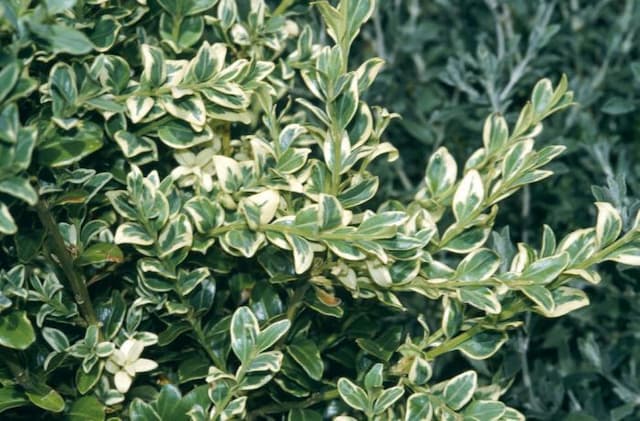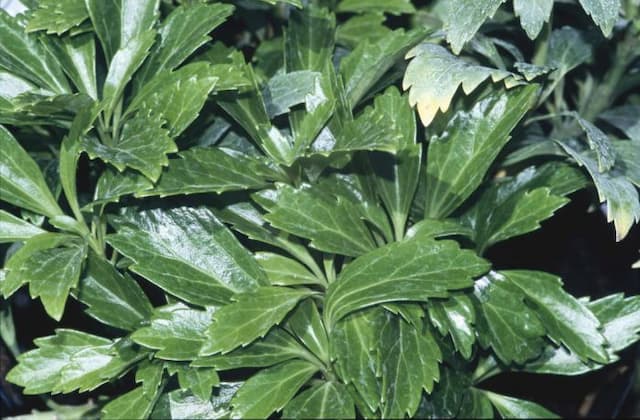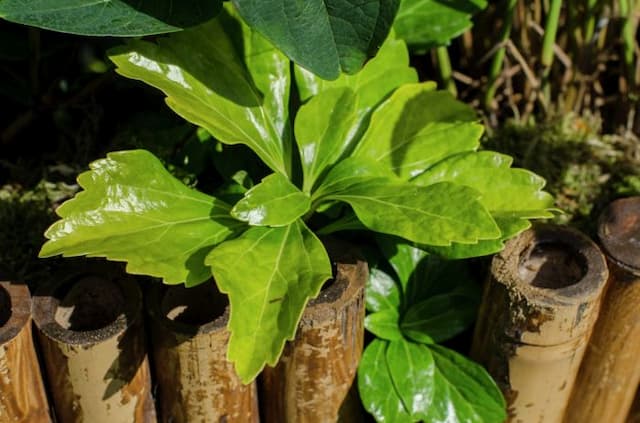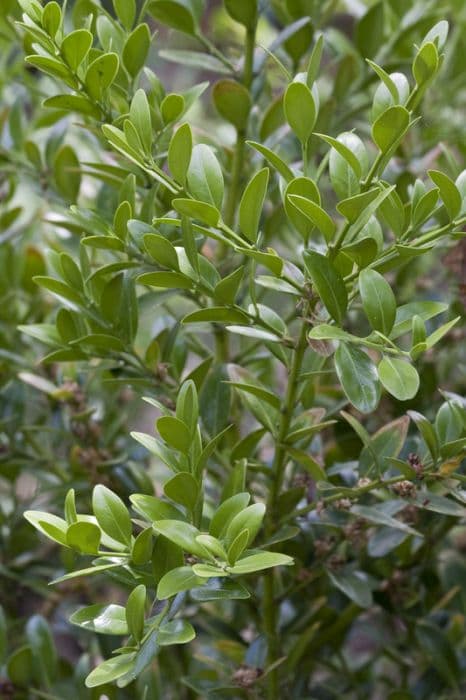Variegated English Boxwood Buxus sempervirens 'Latifolia Maculata' (v)

ABOUT
The plant commonly known as Variegated Boxwood is characterized by its striking foliage. The leaves are broadly oval, showcasing a glossy, rich green color with lighter, often creamy yellow edges that create an eye-catching variegation pattern. This distinctive feature adds an element of visual interest and contrast to gardens and landscapes. The leaves of Variegated Boxwood are small to medium in size, dense, and arranged in an opposite fashion along the stems. This gives the plant a lush, full-bodied appearance. The overall shape of the plant is dense and rounded, with a natural tendency to form a compact, bushy habit. The branches are numerous and can be somewhat pliable, but they contribute to the plant's sturdy and structured look. When left untrimmed, the Variegated Boxwood can develop a somewhat informal shape, but it is also highly amenable to pruning, which allows gardeners to shape it into more formal hedges or topiary forms if desired. During the growing season, the variegated foliage remains evergreen, providing year-round interest. The contrast between the dark green center and the lighter edges of the leaves becomes most pronounced in the spring and summer when new growth emerges. The bush remains relatively subtle though, as it does not produce significant flowers or fruits that would divert attention from its foliage. This makes the Variegated Boxwood a versatile background plant or a standout feature when strategically placed in landscapes.
About this plant
 Names
NamesFamily
Buxaceae
Synonyms
Variegated English Boxwood, Variegated Common Box
Common names
Buxus sempervirens 'Latifolia Maculata'
 Toxicity
ToxicityTo humans
Common box or boxwood is considered toxic to humans if ingested. It contains alkaloids such as buxine which can lead to symptoms of poisoning including nausea, vomiting, diarrhea, dizziness, convulsions, and respiratory failure. In severe cases, ingestion can be fatal, so it is important to avoid consuming any part of the plant.
To pets
Common box or boxwood is also toxic to pets, such as dogs and cats. If ingested, it can cause symptoms that are similar to those in humans, including vomiting, diarrhea, and potentially seizures. The toxic compounds in the plant, like alkaloids and glycosides, can cause severe digestive upset and can also affect the nervous system. Ingress of any part of the plant can be dangerous, and immediate veterinary care is recommended if a pet consumes boxwood.
 Characteristics
CharacteristicsLife cycle
Perennials
Foliage type
Evergreen
Color of leaves
Green
Height
5 feet (1.52 meters)
Spread
5 feet (1.52 meters)
Plant type
Shrub
Hardiness zones
5-9
Native area
Europe
Benefits
 General Benefits
General Benefits- Aesthetic Appeal: Buxus sempervirens 'Latifolia Maculata', commonly known as Variegated Broadleaf Boxwood, offers visual interest with its variegated foliage, adding a splash of color and texture to landscapes.
- Year-Round Interest: This evergreen shrub maintains its foliage throughout the year, providing greenery even in the winter months.
- Formal Design: Variegated Broadleaf Boxwood is often used in formal garden designs, including topiaries, hedges, and garden borders due to its dense growth habit and ease of shaping.
- Drought Tolerance: Once established, it has a degree of drought tolerance, making it suitable for regions with occasional water scarcity.
- Wildlife Support: The dense foliage can provide shelter for birds and other small wildlife, offering a safe haven within garden environments.
- Low Maintenance: This cultivar requires relatively low maintenance once mature, needing only occasional pruning to maintain shape and encourage dense growth.
 Medical Properties
Medical PropertiesThis plant is not used for medical purposes.
 Air-purifying Qualities
Air-purifying QualitiesThis plant is not specifically known for air purifying qualities.
 Other Uses
Other Uses- The common Boxwood can be used as a natural dye for fabrics, providing a range of subtle green hues to textiles.
- Wood from the common Boxwood is sometimes used in the production of musical instruments, such as woodwinds, for its fine grain and workability.
- Boxwood makes excellent material for carving intricate details, used in art pieces and small sculptures.
- Fine woodwork such as marquetry and inlay, which decorate furniture and flooring, often incorporate common Boxwood for its smooth finish and consistent color.
- Historically, Boxwood was used for printing blocks before the advent of modern printing technology.
- Chess pieces are at times handcrafted from Boxwood due to its robust nature and ease of carving.
- Boxwood branches may be used in floral arrangements and wreaths to add structure and an evergreen element that lasts long.
- The dense foliage of the common Boxwood can be used to create intricate garden mazes in landscaped gardens.
- Boxwood clippings can be added to a compost heap, where they break down slowly and add structure to the compost mix.
- In model making, common Boxwood is valued for its fine texture, which allows for precision crafting of small-scale items.
Interesting Facts
 Feng Shui
Feng ShuiThe Boxwood is not used in Feng Shui practice.
 Zodiac Sign Compitability
Zodiac Sign CompitabilityThe Boxwood is not used in astrology practice.
 Plant Symbolism
Plant Symbolism- Everlasting Life: Buxus sempervirens, commonly known as Boxwood, is an evergreen plant, symbolizing immortality and eternal life due to its year-round green leaves.
- Endurance: The hardy nature of Boxwood, which can withstand trimming and shaping, represents strength and the ability to endure life’s challenges.
- Fidelity: Because Boxwood maintains its color and foliage, it often symbolizes faithfulness and unwavering loyalty in relationships.
- Prosperity: Boxwood is frequently planted in elaborate garden designs; thus, it can be a symbol of wealth, success, and material well-being.
- Man's Triumph Over Nature: Given its use in formal gardens for topiaries and hedges, Boxwood can represent the idea of humanity shaping and controlling the natural world.
 Water
WaterThe common boxwood should be watered deeply once a week during the growing season if there isn't sufficient rainfall, ensuring the soil is moist but not soggy. During the hotter summer months, increase watering frequency to twice a week. Each watering session should involve around 1 to 2 gallons of water for smaller shrubs, while larger established boxwoods may require up to 4 gallons. During the dormant season, reduce watering to every two to three weeks, depending on the weather, and cut back on the amount to avoid waterlogging, which can lead to root rot.
 Light
LightThe common boxwood thrives best in a location with partial to full sun exposure. Ideally, it should receive at least 4 to 6 hours of direct sunlight daily but should be sheltered from intense, midday sun to prevent leaf scorch. Placing it in a spot that receives morning sun and afternoon shade will ensure healthy growth and foliage color.
 Temperature
TemperatureCommon boxwoods are hardy and can withstand a temperature range between -10°F to 115°F. The ideal temperature for these plants is between 60°F and 70°F. Extended exposure to temperatures at the extreme ends of their tolerance may stress the plant, so ensure proper mulching to help regulate soil temperature.
 Pruning
PruningThe common boxwood should be pruned to maintain its shape, remove dead or diseased branches, and encourage dense growth. The best time to prune is in late spring after the last frost but before the new growth starts. Prune lightly again in the late summer if necessary to refine the shape. Avoid heavy pruning late in the season, as this can cause new growth that may not harden off before the first frost.
 Cleaning
CleaningAs needed
 Soil
SoilThe best soil mix for Boxwood is one that is well-draining with a mix of two parts loam, one part peat or leaf mold, and one part sand or perlite. This variety prefers a soil pH between 6.5 and 7.5.
 Repotting
RepottingBoxwood should typically be repotted every two to three years in order to replenish the soil and to give the roots new room to grow.
 Humidity & Misting
Humidity & MistingBoxwood thrives in average humidity conditions, and it does not require any special humidity adjustments when cultivated outdoors. Indoor environments should mimic this by avoiding overly dry air.
 Suitable locations
Suitable locationsIndoor
Provide bright, indirect light and avoid extreme temperatures.
Outdoor
Plant in well-draining soil; partial to full sun.
Hardiness zone
5-9 USDA
 Life cycle
Life cycleBuxus sempervirens 'Latifolia Maculata', commonly known as Variegated Common Boxwood, begins its life cycle as a seed, which upon germination in favorable conditions of moist, well-drained soil and partial to full sun exposure, sprouts into a seedling. The young plant enters a vegetative stage characterized by the growth of glossy, variegated leaves that are green with creamy yellow margins and a dense, shrubby form. As it matures, the boxwood enters a period of establishment where its root system expands and it becomes more resistant to environmental stress and pests. At the reproductive stage, the boxwood produces inconspicuous yellow-green flowers in the spring, which are pollinated by insects, leading to the development of small, dehiscent capsules containing seeds. The mature plant may continually undergo a cycle of growth and reproduction annually for many years, as the boxwood is an evergreen with a slow growth rate and a long lifespan. Pruning during the life of the plant helps to maintain shape and health, and it may be propagated through cuttings to continue its legacy.
 Propogation
PropogationPropogation time
Late Winter - Early Spring
The most popular method of propagation for Buxus sempervirens 'Latifolia Maculata', commonly known as Variegated English Boxwood, is through semi-hardwood cuttings. This process is typically carried out in late summer. Cuttings should be about 4 to 6 inches (10 to 15 cm) long and taken from a healthy part of the plant. The lower leaves are removed and the cut end is dipped into a rooting hormone to encourage root development. The prepared cuttings are then inserted in a pot filled with a mix of peat and perlite or coarse sand, ensuring at least two nodes are buried. The pot is kept under high humidity with indirect light and consistently moist but not waterlogged soil. Roots usually develop within 6 to 8 weeks, after which the new plants can be gradually acclimatized to less protective conditions before planting out.









